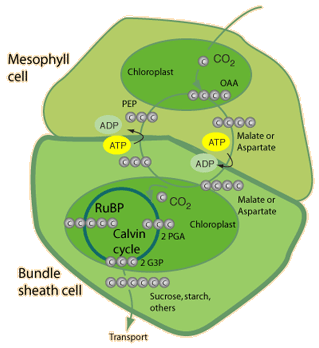The type of photosynthesis discussed in the last blog is referred to as C3 photosynthesis. Some plants have slightly modified mechanisms of carbon fixation due to a particularly dry climate.
Photorespiration- The oxidation of RuBP:
How it happens?
When it is warm, plants close their stoma to save water.
CO2 cannot enter the leaf.
Oxygen concentrations increase.
Oxygen, instead of Carbon dioxide, then bonds to RuBP.
The result?
Less carbohydrates are produced by photosynthesis since PGA molecules are removed— instead of 2 PGAs which are produced during photosynthesis, only one PGA and another 2 carbon glycolate are formed from RuBP.
How is it overcome in hot climates?
C4 photosynthesis
The blow is a good summary of C4 photosynthesis:
Overall, CO2 is added to a 3-carbon PEP molecule forming a 4-carbon OAA, and then malate, which then passes into the bundle sheath cells where the CO2 can be released and used for photosynthesis.
Location: Cytoplasm of mesophyll cell/bundle sheath cell. (spatial separation)
Note:
C3 Photosynthesis: 18 ATP used per glucose molecule.
C4 Photosynthesis: 30 ATP used per glucose molecule.
Crassulacean acid metabolism (CAM)
The below is a good summary of CAM:
Overall, during the night, CO2 is stored in the vacuoles of the plant in the form of organic acids. During the day, this CO2 is released and used for photosynthesis.
Location: Cytoplasm (all in one place; different from C4 photosynthesis - Temporal Separation: day/night)



No comments:
Post a Comment